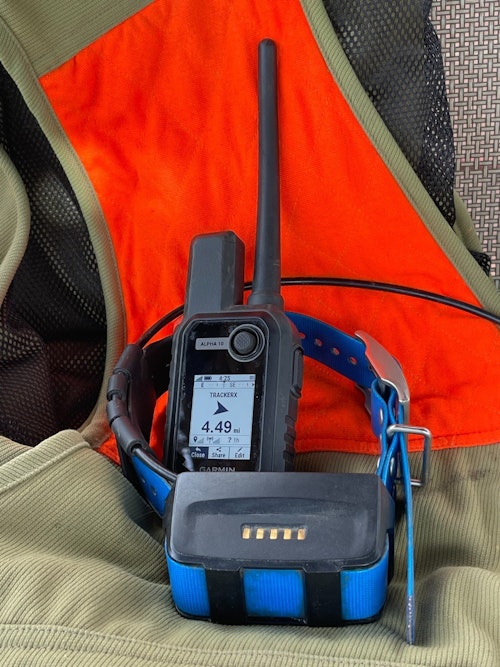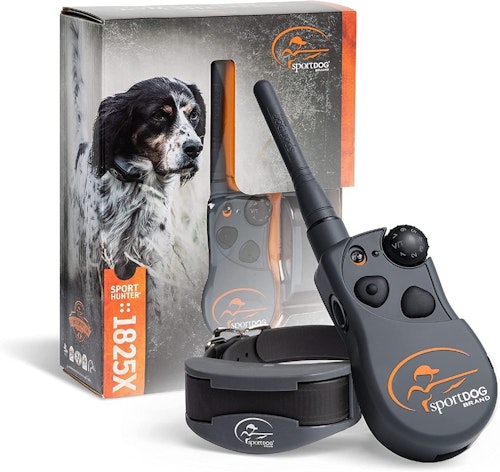There was a time in the not-too-distant past when e-collars were brand new and somewhat primitive, and many who tried to use the training aids actually misused them, sometimes causing irreparable harm to their dog-training process. Fortunately, e-collars have come a long way in the past few decades. Most now are much more sophisticated and easier to use, and they’re considered by most to be viable, humane training aids.
Today’s modern e-collars are, indeed, more than just the “shock collars” of yesteryear. True, there are some that are designed solely to send stimulation to a dog — whether a beep, buzz or mild electrical impulse — and they undoubtedly have their place in training bird dogs, retrievers, spaniels, hounds and a variety of other types of hunting and even non-hunting dogs.
Others are designed solely for tracking canines and have built-in GPS function in both the collar and the handheld transmitter. These typically tell hunters or others utilizing them which direction their dog is and how far it is away from the transmitter. These are especially handy for big-running bird dogs who tend to be out of eyesight for extended periods of time and also will stand pointed on birds for hours regardless of how loudly you call them. These collars typically have an extended range, many tracking the collar five or more miles away.
Still others are designed as “track and train” units, giving dog owners the ability to track their dogs and also administer training stimulation with the same unit. These are commonly more expensive, but many people find them well worth the extra money since they perform two functions and alleviate the need for separate collars for training and tracking.
One word of note is needed here. Regardless of what some people with little knowledge of training collars might say, these devices are not innately cruel or inhumane. Yes, when misused, they can be both of those things. But when used properly, they pose no danger to a dog. It’s easy to see that simply by watching a retriever or pointing dog run up to his owner and stick his neck out waiting to have his collar put in place so he can get about the business of doing what he loves to do.
Now, let’s take a brief look at three e-collars common on the market, exploring what they offer and some of their advantages and disadvantages.
Dogtra Pathfinder
The Dogtra Pathfinder is a unique track-and-train collar in that it has no handheld transmitter, but instead utilizes your cell phone and a corresponding smartphone app to control both the tracking and training functions.
I used a Pathfinder for about three years until I recently made a change, and I found it to do everything as advertised. However, it was a little hard for me — being a somewhat old guy who isn’t very tech savvy — to operate it efficiently. For me, it was great for tracking, and it was easy to get to the screen where I could see all my collared dogs at the same time. However, using the training function was difficult. It seemed that right when I needed it, the screen was on another dog. Or — and this really happened a time or two — right when I was walking in to flush a bird and planned to use the training function if a correction was needed, someone would call me on my phone and the screen would go to my caller ID screen, leaving me hanging for the training scenario.
Don’t get me wrong: I used the Pathfinder successfully for a number of years before I finally decided to make a change. Operating the functions of the system from my cell phone was just more of a hassle than I was willing to put up with because I never really took the time to learn all the functions well enough to fully utilize the training aspect.
In the end, it’s a good, budget-minded unit that most hunters and dog trainers will find completely functional, and the $399 price tag historically put it way less expensive than its competitors — until recently.
Garmin Alpha 10
I ended the section on the Dogtra with “until recently” because Garmin recently shook up the world of track and train collars. In the past, Garmin — the undisputed leader in all things GPS — offered a number of track-and-train collars, but the price point was well beyond what many hunters and dog trainers were willing to pay. The new Garmin Alpha 10, at $499, changed all that by offering Garmin quality and reliability at only $100 more than the Dogtra Pathfinder unit.
With a handheld unit much smaller than its predecessors, the Garmin 10 offers tracking and training for up to 20 dogs and has an astounding range of about nine miles. Users are able to store a custom training setting for each dog and toggle through dogs on the screen with a “joystick” located above the screen.
For those who don’t need the training function, the Alpha 10 can also be used with Garmin’s tracking-only T5 or T5 mini collars. That makes it legal for most pointing dog field trials, where the units are left off during competition unless a dog is lost and the handler has to resort to using the collar to find it after being out of contention. Best of all, the Alpha 10 is compatible with my Garmin Instinct watch, allowing me to keep the handheld in my vest pocket and monitor where my dogs are during training simply by glancing at my watch.
I can’t, however, say the unit is always intuitive and easy to use — at least for me. At many times I end up on the wrong screen and don’t have sufficient knowledge to find my way back where I want to be. Also, the training function is more difficult than many units because I have to toggle through dogs, then use a button that isn’t raised and difficult to find without looking. All in all, however, this is a great collar at a really good price that has helped many people get a Garmin who wouldn’t have thought it possible before this unit was introduced.
SportDOG SportHunter
Some hunters and dog trainers don’t need a tracking function for a variety of reasons. If they train retrievers, they seldom run a quarter mile or more away, making a GPS unit unnecessary. Likewise, some people with close-working dogs who they keep visual contact with at nearly all times find a tracking function to be somewhat of an unneeded luxury that’s not worth the added expense. Those are the people looking for a simple training unit.
To say that this is an easy-to-use unit would be an understatement. I’ve used one off and on for a couple of years and believe it to be one of the most straight-forward collars on the market that should be intuitive for nearly anyone — even people who’ve not used an e-collar before — without having to take their eyes off their dogs.
There are several SportHunter models in the SportDOG lineup. All have up to 21 levels of static stimulation with low and medium range, as well as options to train with vibration or tone. Most support up to three dogs, and it’s easy to choose which dog you are training by flipping a simple toggle switch on the front of the handheld device.
The SportDOG system utilizes lithium-ion batteries that charge in about two hours and last 50 to 70 hours per charge. Plus, the system has low-battery indicators so you’re never left hanging out in the field. With a range of about one mile, this unit will certainly meet the training collar needs of the vast majority of hunters and even many field trailers.









